DSAA204/BIT204: Inventory Management Report for XYZ Stores
VerifiedAdded on 2022/11/10
|13
|3361
|76
Report
AI Summary
This report focuses on designing an inventory management system for XYZ Stores, a company dealing with household and food items. The report begins by outlining the variables, keys, and ranges used to track approximately 300 household and 200 food items, considering product type, name, price, and manufacturer. It justifies the choices made for these constraints, emphasizing their role in efficient product searching and sorting. The core of the report details the implementation of the Quick Sort algorithm for managing the inventory. It includes a discussion of library operations, the algorithm's functionality, and its pseudo-code implementation. The report also addresses the implications of a company merger, which would significantly increase the number of items in inventory, and proposes changes to the existing system, such as adding barcodes to facilitate product identification and management. This report provides a comprehensive overview of the inventory management system, including variables, algorithm implementation, and proposed changes.
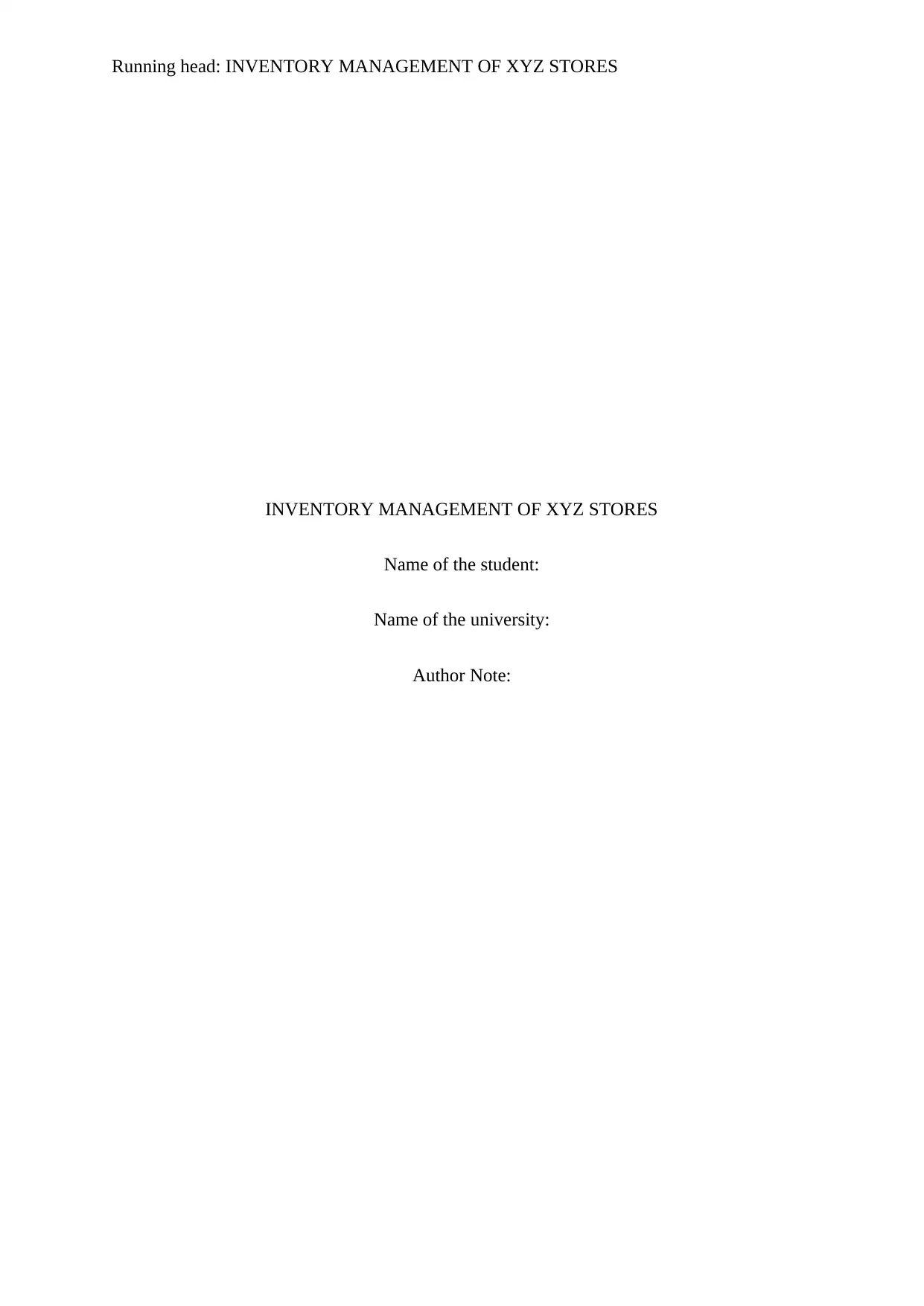
Running head: INVENTORY MANAGEMENT OF XYZ STORES
INVENTORY MANAGEMENT OF XYZ STORES
Name of the student:
Name of the university:
Author Note:
INVENTORY MANAGEMENT OF XYZ STORES
Name of the student:
Name of the university:
Author Note:
Paraphrase This Document
Need a fresh take? Get an instant paraphrase of this document with our AI Paraphraser
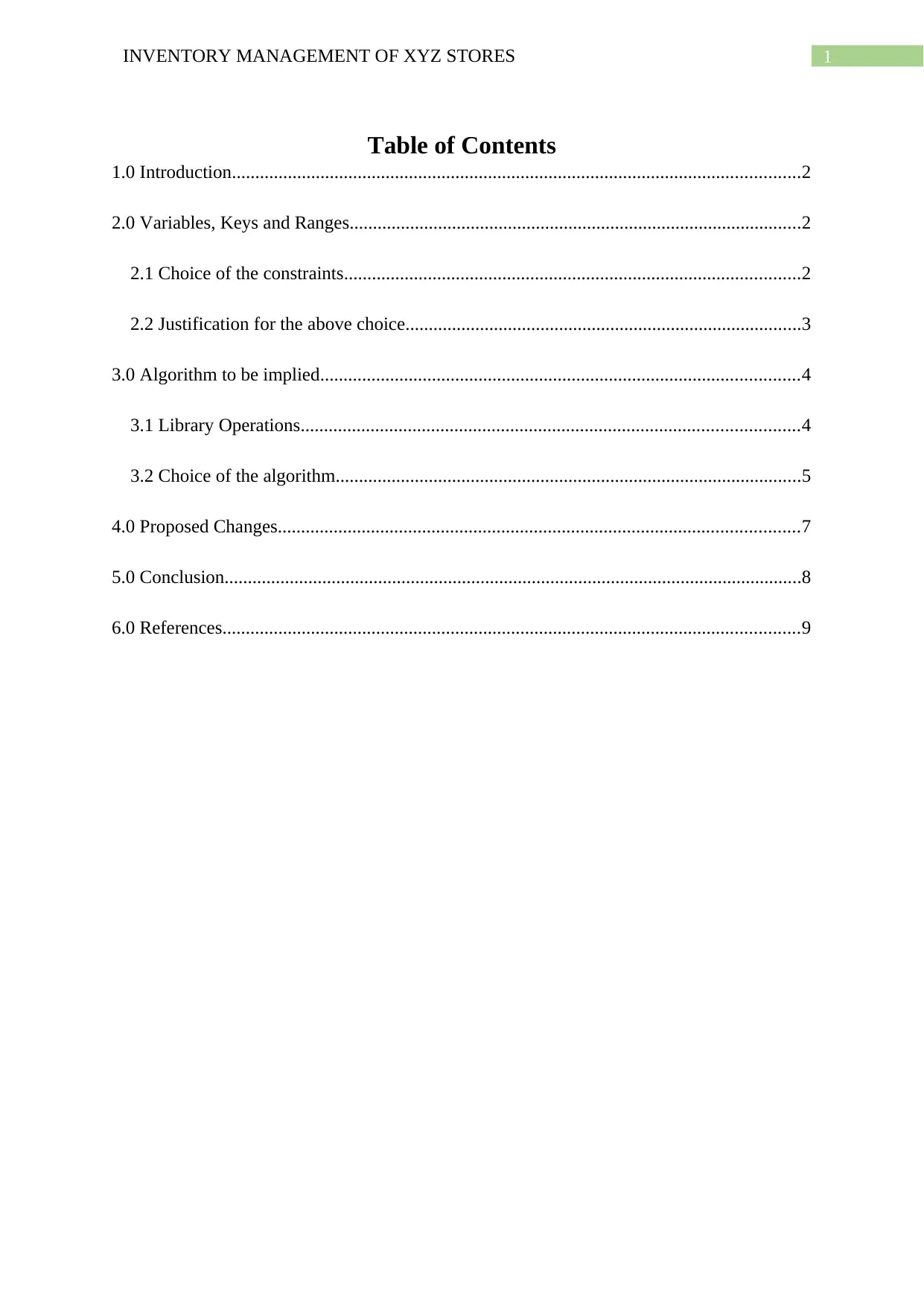
1INVENTORY MANAGEMENT OF XYZ STORES
Table of Contents
1.0 Introduction..........................................................................................................................2
2.0 Variables, Keys and Ranges.................................................................................................2
2.1 Choice of the constraints..................................................................................................2
2.2 Justification for the above choice.....................................................................................3
3.0 Algorithm to be implied.......................................................................................................4
3.1 Library Operations...........................................................................................................4
3.2 Choice of the algorithm....................................................................................................5
4.0 Proposed Changes................................................................................................................7
5.0 Conclusion............................................................................................................................8
6.0 References............................................................................................................................9
Table of Contents
1.0 Introduction..........................................................................................................................2
2.0 Variables, Keys and Ranges.................................................................................................2
2.1 Choice of the constraints..................................................................................................2
2.2 Justification for the above choice.....................................................................................3
3.0 Algorithm to be implied.......................................................................................................4
3.1 Library Operations...........................................................................................................4
3.2 Choice of the algorithm....................................................................................................5
4.0 Proposed Changes................................................................................................................7
5.0 Conclusion............................................................................................................................8
6.0 References............................................................................................................................9
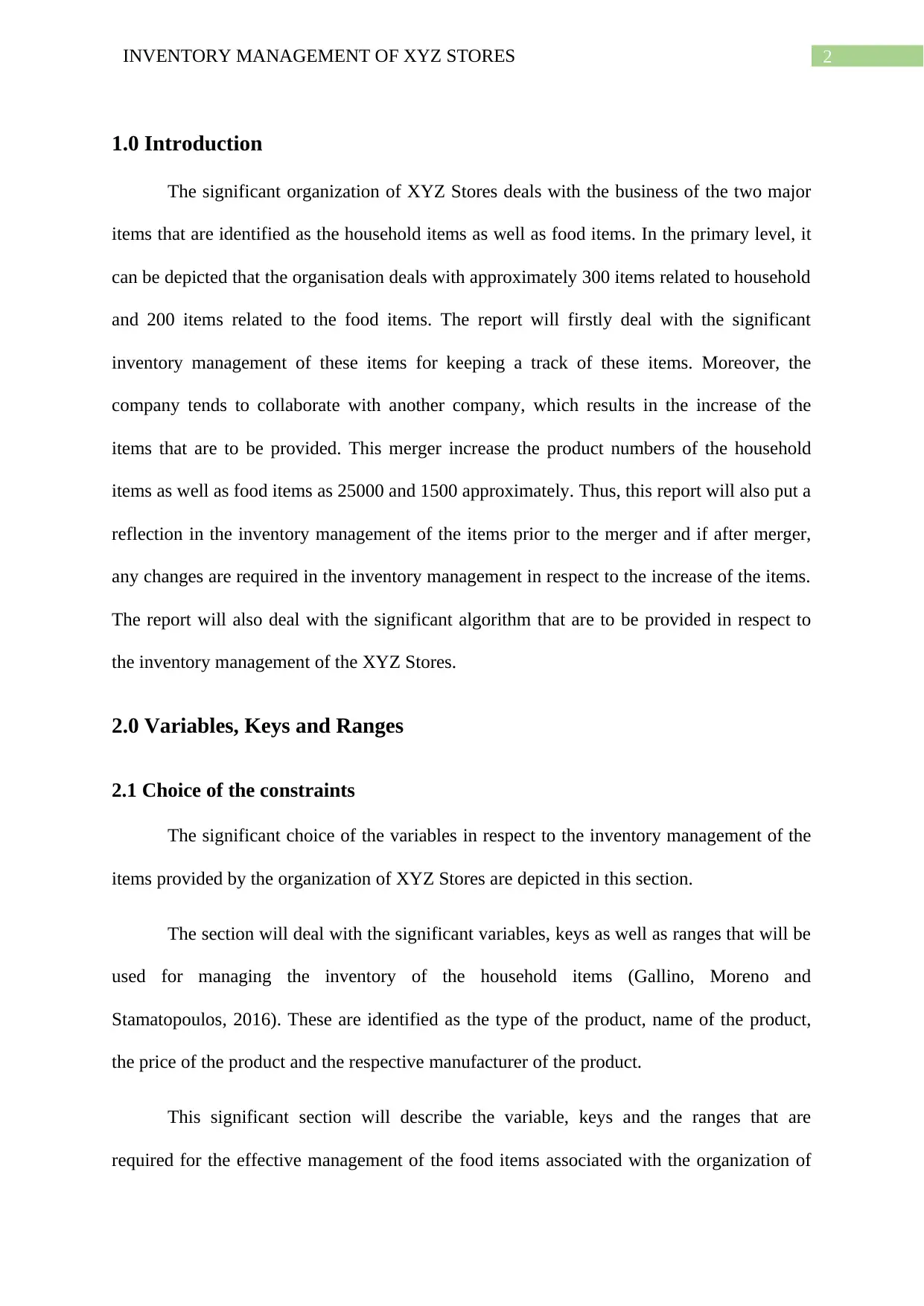
2INVENTORY MANAGEMENT OF XYZ STORES
1.0 Introduction
The significant organization of XYZ Stores deals with the business of the two major
items that are identified as the household items as well as food items. In the primary level, it
can be depicted that the organisation deals with approximately 300 items related to household
and 200 items related to the food items. The report will firstly deal with the significant
inventory management of these items for keeping a track of these items. Moreover, the
company tends to collaborate with another company, which results in the increase of the
items that are to be provided. This merger increase the product numbers of the household
items as well as food items as 25000 and 1500 approximately. Thus, this report will also put a
reflection in the inventory management of the items prior to the merger and if after merger,
any changes are required in the inventory management in respect to the increase of the items.
The report will also deal with the significant algorithm that are to be provided in respect to
the inventory management of the XYZ Stores.
2.0 Variables, Keys and Ranges
2.1 Choice of the constraints
The significant choice of the variables in respect to the inventory management of the
items provided by the organization of XYZ Stores are depicted in this section.
The section will deal with the significant variables, keys as well as ranges that will be
used for managing the inventory of the household items (Gallino, Moreno and
Stamatopoulos, 2016). These are identified as the type of the product, name of the product,
the price of the product and the respective manufacturer of the product.
This significant section will describe the variable, keys and the ranges that are
required for the effective management of the food items associated with the organization of
1.0 Introduction
The significant organization of XYZ Stores deals with the business of the two major
items that are identified as the household items as well as food items. In the primary level, it
can be depicted that the organisation deals with approximately 300 items related to household
and 200 items related to the food items. The report will firstly deal with the significant
inventory management of these items for keeping a track of these items. Moreover, the
company tends to collaborate with another company, which results in the increase of the
items that are to be provided. This merger increase the product numbers of the household
items as well as food items as 25000 and 1500 approximately. Thus, this report will also put a
reflection in the inventory management of the items prior to the merger and if after merger,
any changes are required in the inventory management in respect to the increase of the items.
The report will also deal with the significant algorithm that are to be provided in respect to
the inventory management of the XYZ Stores.
2.0 Variables, Keys and Ranges
2.1 Choice of the constraints
The significant choice of the variables in respect to the inventory management of the
items provided by the organization of XYZ Stores are depicted in this section.
The section will deal with the significant variables, keys as well as ranges that will be
used for managing the inventory of the household items (Gallino, Moreno and
Stamatopoulos, 2016). These are identified as the type of the product, name of the product,
the price of the product and the respective manufacturer of the product.
This significant section will describe the variable, keys and the ranges that are
required for the effective management of the food items associated with the organization of
⊘ This is a preview!⊘
Do you want full access?
Subscribe today to unlock all pages.

Trusted by 1+ million students worldwide
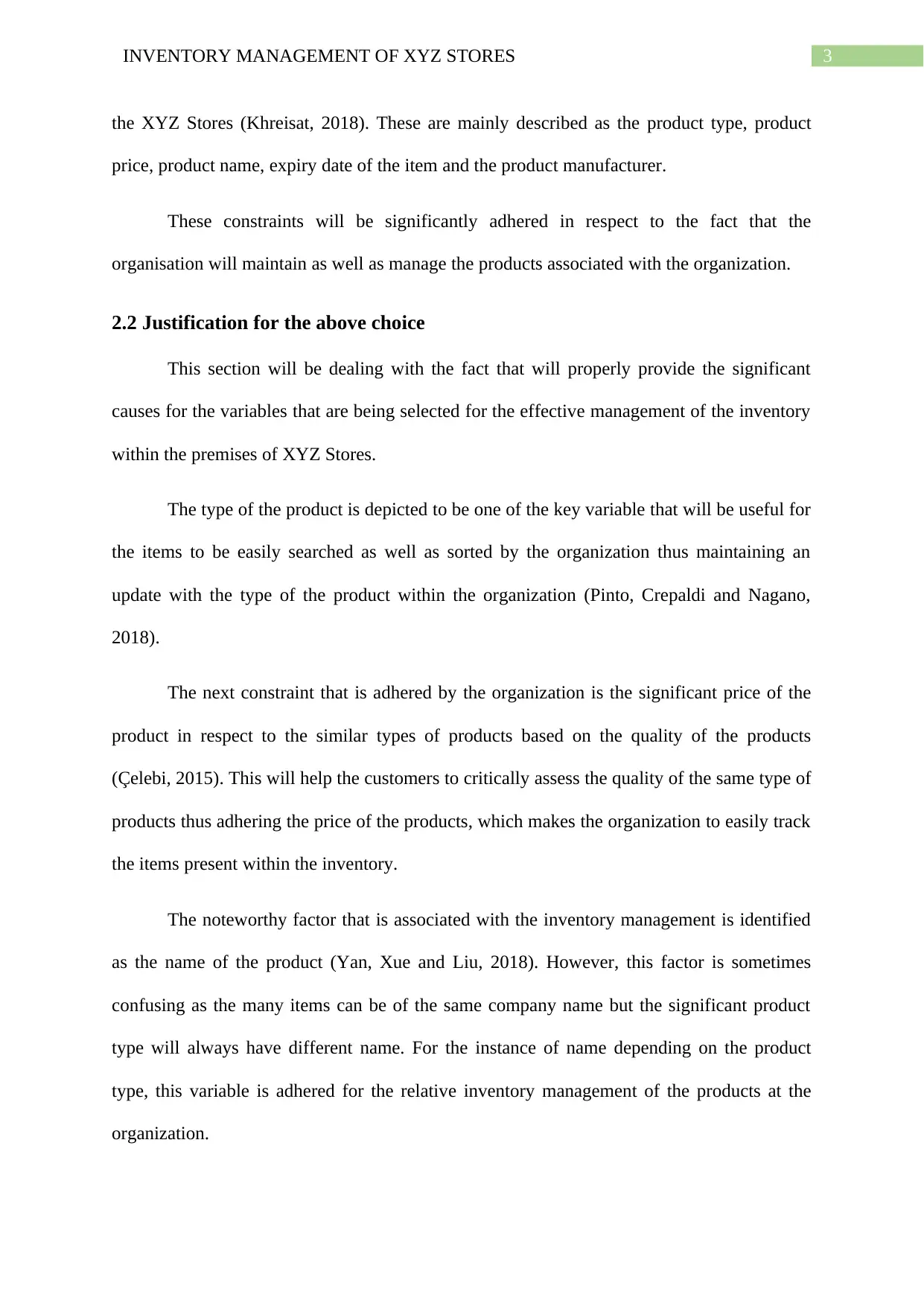
3INVENTORY MANAGEMENT OF XYZ STORES
the XYZ Stores (Khreisat, 2018). These are mainly described as the product type, product
price, product name, expiry date of the item and the product manufacturer.
These constraints will be significantly adhered in respect to the fact that the
organisation will maintain as well as manage the products associated with the organization.
2.2 Justification for the above choice
This section will be dealing with the fact that will properly provide the significant
causes for the variables that are being selected for the effective management of the inventory
within the premises of XYZ Stores.
The type of the product is depicted to be one of the key variable that will be useful for
the items to be easily searched as well as sorted by the organization thus maintaining an
update with the type of the product within the organization (Pinto, Crepaldi and Nagano,
2018).
The next constraint that is adhered by the organization is the significant price of the
product in respect to the similar types of products based on the quality of the products
(Çelebi, 2015). This will help the customers to critically assess the quality of the same type of
products thus adhering the price of the products, which makes the organization to easily track
the items present within the inventory.
The noteworthy factor that is associated with the inventory management is identified
as the name of the product (Yan, Xue and Liu, 2018). However, this factor is sometimes
confusing as the many items can be of the same company name but the significant product
type will always have different name. For the instance of name depending on the product
type, this variable is adhered for the relative inventory management of the products at the
organization.
the XYZ Stores (Khreisat, 2018). These are mainly described as the product type, product
price, product name, expiry date of the item and the product manufacturer.
These constraints will be significantly adhered in respect to the fact that the
organisation will maintain as well as manage the products associated with the organization.
2.2 Justification for the above choice
This section will be dealing with the fact that will properly provide the significant
causes for the variables that are being selected for the effective management of the inventory
within the premises of XYZ Stores.
The type of the product is depicted to be one of the key variable that will be useful for
the items to be easily searched as well as sorted by the organization thus maintaining an
update with the type of the product within the organization (Pinto, Crepaldi and Nagano,
2018).
The next constraint that is adhered by the organization is the significant price of the
product in respect to the similar types of products based on the quality of the products
(Çelebi, 2015). This will help the customers to critically assess the quality of the same type of
products thus adhering the price of the products, which makes the organization to easily track
the items present within the inventory.
The noteworthy factor that is associated with the inventory management is identified
as the name of the product (Yan, Xue and Liu, 2018). However, this factor is sometimes
confusing as the many items can be of the same company name but the significant product
type will always have different name. For the instance of name depending on the product
type, this variable is adhered for the relative inventory management of the products at the
organization.
Paraphrase This Document
Need a fresh take? Get an instant paraphrase of this document with our AI Paraphraser
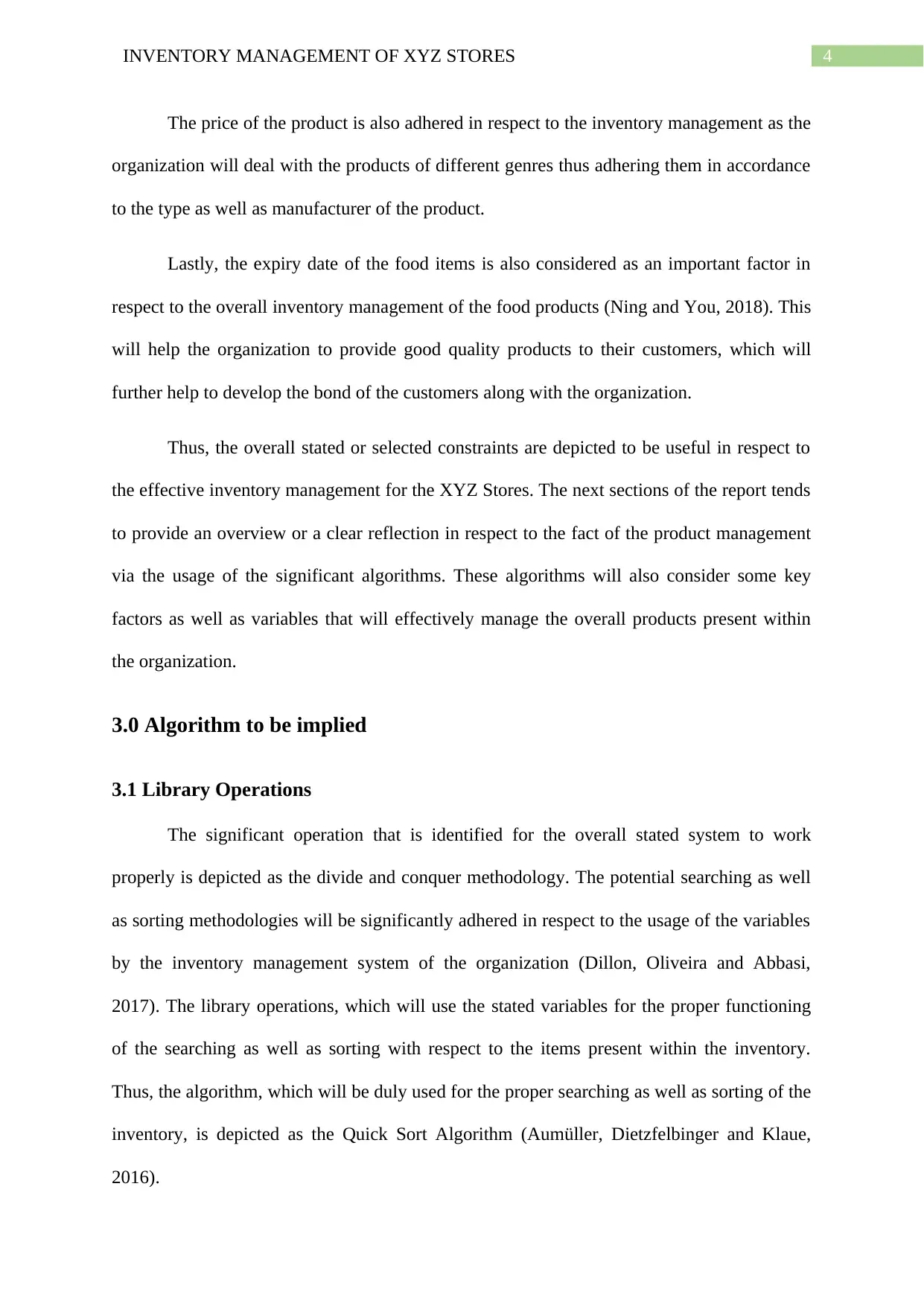
4INVENTORY MANAGEMENT OF XYZ STORES
The price of the product is also adhered in respect to the inventory management as the
organization will deal with the products of different genres thus adhering them in accordance
to the type as well as manufacturer of the product.
Lastly, the expiry date of the food items is also considered as an important factor in
respect to the overall inventory management of the food products (Ning and You, 2018). This
will help the organization to provide good quality products to their customers, which will
further help to develop the bond of the customers along with the organization.
Thus, the overall stated or selected constraints are depicted to be useful in respect to
the effective inventory management for the XYZ Stores. The next sections of the report tends
to provide an overview or a clear reflection in respect to the fact of the product management
via the usage of the significant algorithms. These algorithms will also consider some key
factors as well as variables that will effectively manage the overall products present within
the organization.
3.0 Algorithm to be implied
3.1 Library Operations
The significant operation that is identified for the overall stated system to work
properly is depicted as the divide and conquer methodology. The potential searching as well
as sorting methodologies will be significantly adhered in respect to the usage of the variables
by the inventory management system of the organization (Dillon, Oliveira and Abbasi,
2017). The library operations, which will use the stated variables for the proper functioning
of the searching as well as sorting with respect to the items present within the inventory.
Thus, the algorithm, which will be duly used for the proper searching as well as sorting of the
inventory, is depicted as the Quick Sort Algorithm (Aumüller, Dietzfelbinger and Klaue,
2016).
The price of the product is also adhered in respect to the inventory management as the
organization will deal with the products of different genres thus adhering them in accordance
to the type as well as manufacturer of the product.
Lastly, the expiry date of the food items is also considered as an important factor in
respect to the overall inventory management of the food products (Ning and You, 2018). This
will help the organization to provide good quality products to their customers, which will
further help to develop the bond of the customers along with the organization.
Thus, the overall stated or selected constraints are depicted to be useful in respect to
the effective inventory management for the XYZ Stores. The next sections of the report tends
to provide an overview or a clear reflection in respect to the fact of the product management
via the usage of the significant algorithms. These algorithms will also consider some key
factors as well as variables that will effectively manage the overall products present within
the organization.
3.0 Algorithm to be implied
3.1 Library Operations
The significant operation that is identified for the overall stated system to work
properly is depicted as the divide and conquer methodology. The potential searching as well
as sorting methodologies will be significantly adhered in respect to the usage of the variables
by the inventory management system of the organization (Dillon, Oliveira and Abbasi,
2017). The library operations, which will use the stated variables for the proper functioning
of the searching as well as sorting with respect to the items present within the inventory.
Thus, the algorithm, which will be duly used for the proper searching as well as sorting of the
inventory, is depicted as the Quick Sort Algorithm (Aumüller, Dietzfelbinger and Klaue,
2016).
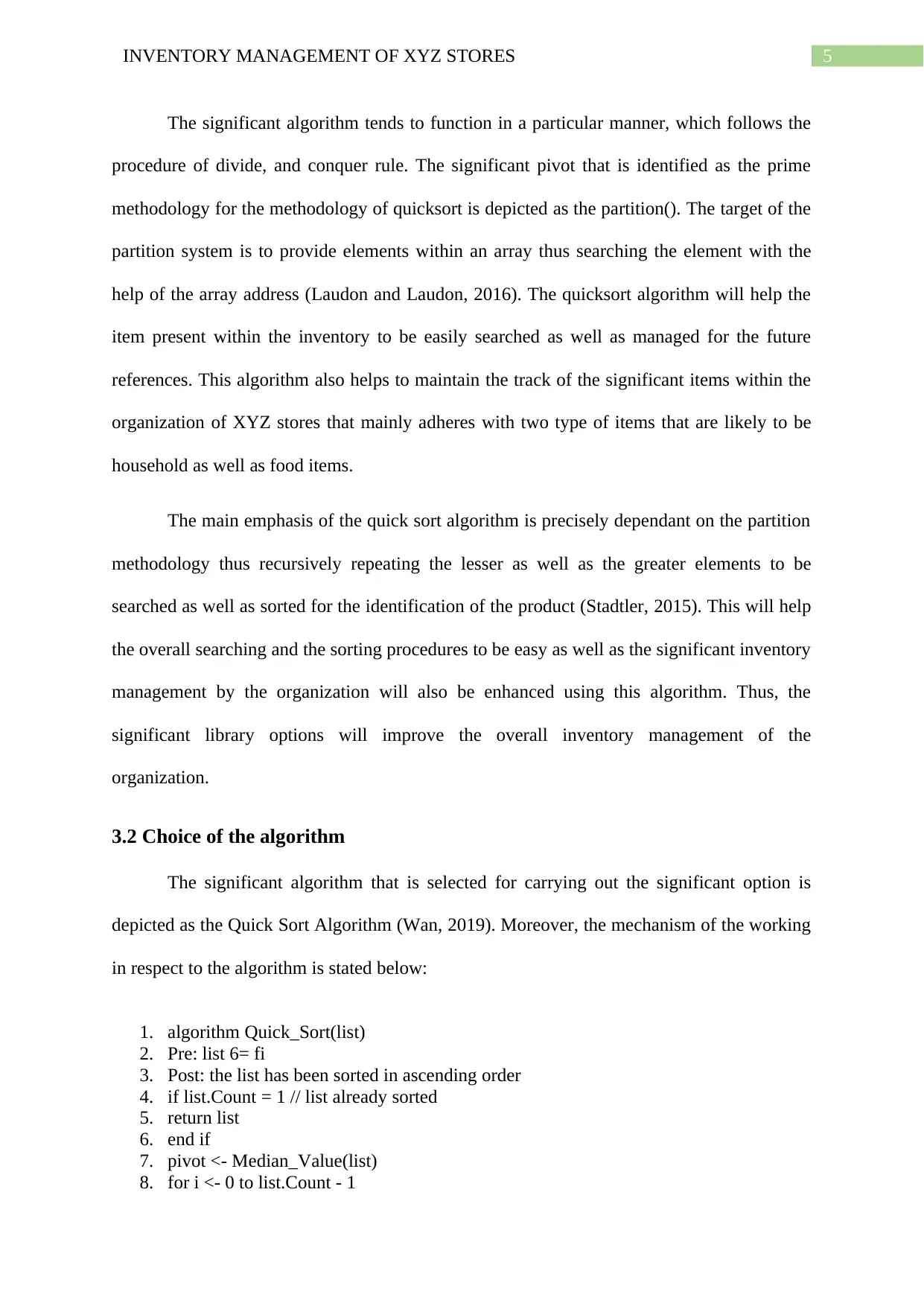
5INVENTORY MANAGEMENT OF XYZ STORES
The significant algorithm tends to function in a particular manner, which follows the
procedure of divide, and conquer rule. The significant pivot that is identified as the prime
methodology for the methodology of quicksort is depicted as the partition(). The target of the
partition system is to provide elements within an array thus searching the element with the
help of the array address (Laudon and Laudon, 2016). The quicksort algorithm will help the
item present within the inventory to be easily searched as well as managed for the future
references. This algorithm also helps to maintain the track of the significant items within the
organization of XYZ stores that mainly adheres with two type of items that are likely to be
household as well as food items.
The main emphasis of the quick sort algorithm is precisely dependant on the partition
methodology thus recursively repeating the lesser as well as the greater elements to be
searched as well as sorted for the identification of the product (Stadtler, 2015). This will help
the overall searching and the sorting procedures to be easy as well as the significant inventory
management by the organization will also be enhanced using this algorithm. Thus, the
significant library options will improve the overall inventory management of the
organization.
3.2 Choice of the algorithm
The significant algorithm that is selected for carrying out the significant option is
depicted as the Quick Sort Algorithm (Wan, 2019). Moreover, the mechanism of the working
in respect to the algorithm is stated below:
1. algorithm Quick_Sort(list)
2. Pre: list 6= fi
3. Post: the list has been sorted in ascending order
4. if list.Count = 1 // list already sorted
5. return list
6. end if
7. pivot <- Median_Value(list)
8. for i <- 0 to list.Count - 1
The significant algorithm tends to function in a particular manner, which follows the
procedure of divide, and conquer rule. The significant pivot that is identified as the prime
methodology for the methodology of quicksort is depicted as the partition(). The target of the
partition system is to provide elements within an array thus searching the element with the
help of the array address (Laudon and Laudon, 2016). The quicksort algorithm will help the
item present within the inventory to be easily searched as well as managed for the future
references. This algorithm also helps to maintain the track of the significant items within the
organization of XYZ stores that mainly adheres with two type of items that are likely to be
household as well as food items.
The main emphasis of the quick sort algorithm is precisely dependant on the partition
methodology thus recursively repeating the lesser as well as the greater elements to be
searched as well as sorted for the identification of the product (Stadtler, 2015). This will help
the overall searching and the sorting procedures to be easy as well as the significant inventory
management by the organization will also be enhanced using this algorithm. Thus, the
significant library options will improve the overall inventory management of the
organization.
3.2 Choice of the algorithm
The significant algorithm that is selected for carrying out the significant option is
depicted as the Quick Sort Algorithm (Wan, 2019). Moreover, the mechanism of the working
in respect to the algorithm is stated below:
1. algorithm Quick_Sort(list)
2. Pre: list 6= fi
3. Post: the list has been sorted in ascending order
4. if list.Count = 1 // list already sorted
5. return list
6. end if
7. pivot <- Median_Value(list)
8. for i <- 0 to list.Count - 1
⊘ This is a preview!⊘
Do you want full access?
Subscribe today to unlock all pages.

Trusted by 1+ million students worldwide
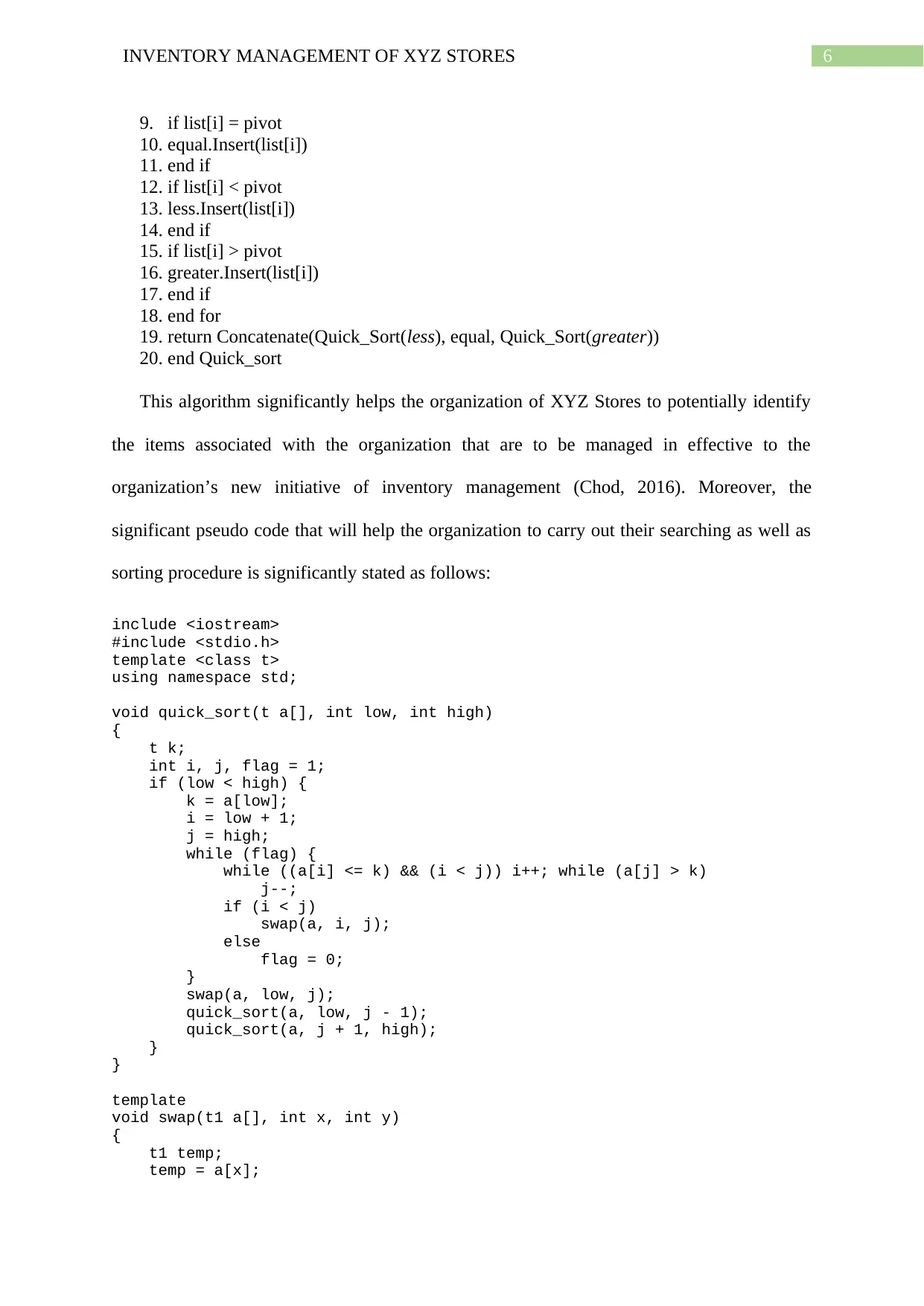
6INVENTORY MANAGEMENT OF XYZ STORES
9. if list[i] = pivot
10. equal.Insert(list[i])
11. end if
12. if list[i] < pivot
13. less.Insert(list[i])
14. end if
15. if list[i] > pivot
16. greater.Insert(list[i])
17. end if
18. end for
19. return Concatenate(Quick_Sort(less), equal, Quick_Sort(greater))
20. end Quick_sort
This algorithm significantly helps the organization of XYZ Stores to potentially identify
the items associated with the organization that are to be managed in effective to the
organization’s new initiative of inventory management (Chod, 2016). Moreover, the
significant pseudo code that will help the organization to carry out their searching as well as
sorting procedure is significantly stated as follows:
include <iostream>
#include <stdio.h>
template <class t>
using namespace std;
void quick_sort(t a[], int low, int high)
{
t k;
int i, j, flag = 1;
if (low < high) {
k = a[low];
i = low + 1;
j = high;
while (flag) {
while ((a[i] <= k) && (i < j)) i++; while (a[j] > k)
j--;
if (i < j)
swap(a, i, j);
else
flag = 0;
}
swap(a, low, j);
quick_sort(a, low, j - 1);
quick_sort(a, j + 1, high);
}
}
template
void swap(t1 a[], int x, int y)
{
t1 temp;
temp = a[x];
9. if list[i] = pivot
10. equal.Insert(list[i])
11. end if
12. if list[i] < pivot
13. less.Insert(list[i])
14. end if
15. if list[i] > pivot
16. greater.Insert(list[i])
17. end if
18. end for
19. return Concatenate(Quick_Sort(less), equal, Quick_Sort(greater))
20. end Quick_sort
This algorithm significantly helps the organization of XYZ Stores to potentially identify
the items associated with the organization that are to be managed in effective to the
organization’s new initiative of inventory management (Chod, 2016). Moreover, the
significant pseudo code that will help the organization to carry out their searching as well as
sorting procedure is significantly stated as follows:
include <iostream>
#include <stdio.h>
template <class t>
using namespace std;
void quick_sort(t a[], int low, int high)
{
t k;
int i, j, flag = 1;
if (low < high) {
k = a[low];
i = low + 1;
j = high;
while (flag) {
while ((a[i] <= k) && (i < j)) i++; while (a[j] > k)
j--;
if (i < j)
swap(a, i, j);
else
flag = 0;
}
swap(a, low, j);
quick_sort(a, low, j - 1);
quick_sort(a, j + 1, high);
}
}
template
void swap(t1 a[], int x, int y)
{
t1 temp;
temp = a[x];
Paraphrase This Document
Need a fresh take? Get an instant paraphrase of this document with our AI Paraphraser
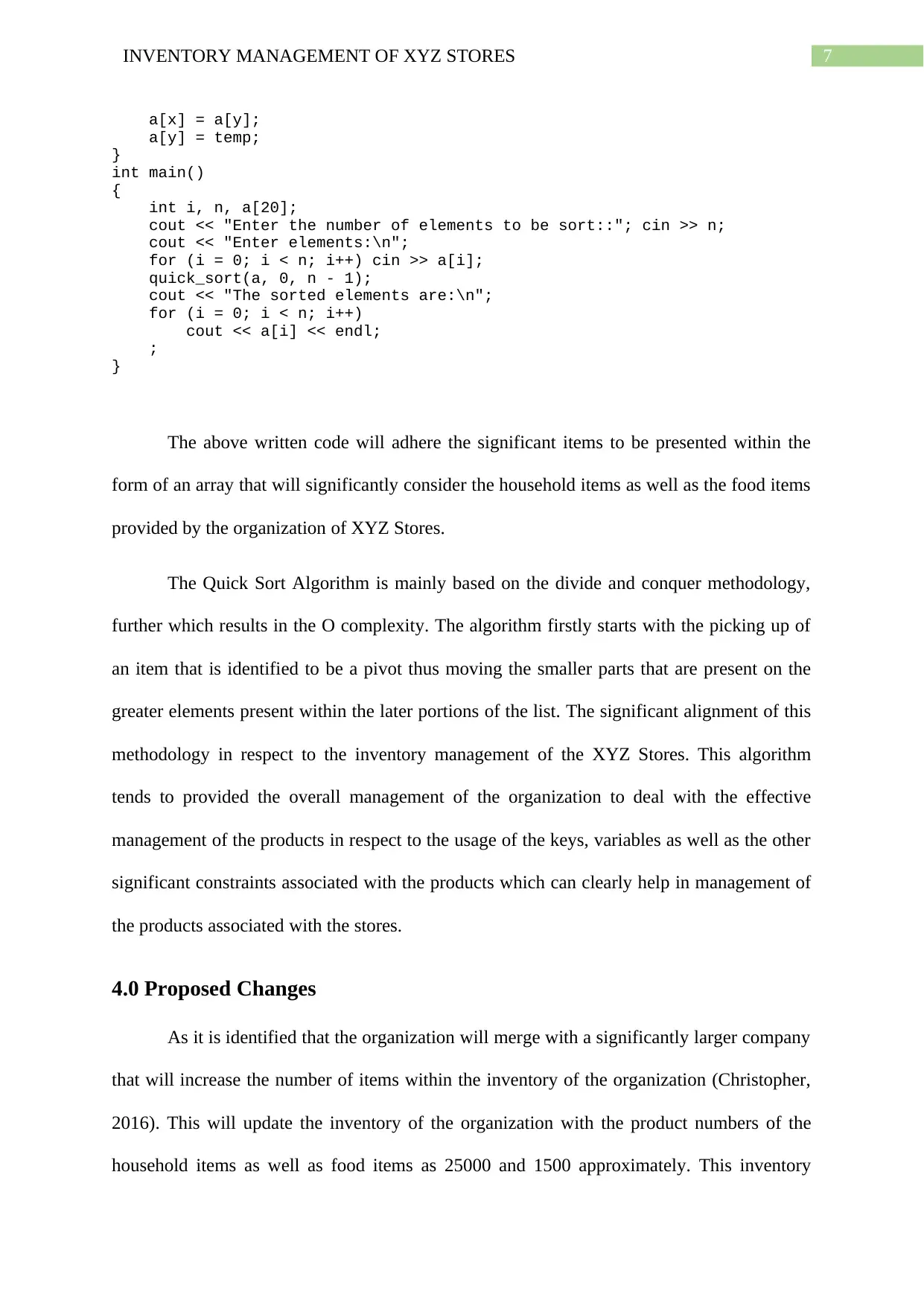
7INVENTORY MANAGEMENT OF XYZ STORES
a[x] = a[y];
a[y] = temp;
}
int main()
{
int i, n, a[20];
cout << "Enter the number of elements to be sort::"; cin >> n;
cout << "Enter elements:\n";
for (i = 0; i < n; i++) cin >> a[i];
quick_sort(a, 0, n - 1);
cout << "The sorted elements are:\n";
for (i = 0; i < n; i++)
cout << a[i] << endl;
;
}
The above written code will adhere the significant items to be presented within the
form of an array that will significantly consider the household items as well as the food items
provided by the organization of XYZ Stores.
The Quick Sort Algorithm is mainly based on the divide and conquer methodology,
further which results in the O complexity. The algorithm firstly starts with the picking up of
an item that is identified to be a pivot thus moving the smaller parts that are present on the
greater elements present within the later portions of the list. The significant alignment of this
methodology in respect to the inventory management of the XYZ Stores. This algorithm
tends to provided the overall management of the organization to deal with the effective
management of the products in respect to the usage of the keys, variables as well as the other
significant constraints associated with the products which can clearly help in management of
the products associated with the stores.
4.0 Proposed Changes
As it is identified that the organization will merge with a significantly larger company
that will increase the number of items within the inventory of the organization (Christopher,
2016). This will update the inventory of the organization with the product numbers of the
household items as well as food items as 25000 and 1500 approximately. This inventory
a[x] = a[y];
a[y] = temp;
}
int main()
{
int i, n, a[20];
cout << "Enter the number of elements to be sort::"; cin >> n;
cout << "Enter elements:\n";
for (i = 0; i < n; i++) cin >> a[i];
quick_sort(a, 0, n - 1);
cout << "The sorted elements are:\n";
for (i = 0; i < n; i++)
cout << a[i] << endl;
;
}
The above written code will adhere the significant items to be presented within the
form of an array that will significantly consider the household items as well as the food items
provided by the organization of XYZ Stores.
The Quick Sort Algorithm is mainly based on the divide and conquer methodology,
further which results in the O complexity. The algorithm firstly starts with the picking up of
an item that is identified to be a pivot thus moving the smaller parts that are present on the
greater elements present within the later portions of the list. The significant alignment of this
methodology in respect to the inventory management of the XYZ Stores. This algorithm
tends to provided the overall management of the organization to deal with the effective
management of the products in respect to the usage of the keys, variables as well as the other
significant constraints associated with the products which can clearly help in management of
the products associated with the stores.
4.0 Proposed Changes
As it is identified that the organization will merge with a significantly larger company
that will increase the number of items within the inventory of the organization (Christopher,
2016). This will update the inventory of the organization with the product numbers of the
household items as well as food items as 25000 and 1500 approximately. This inventory
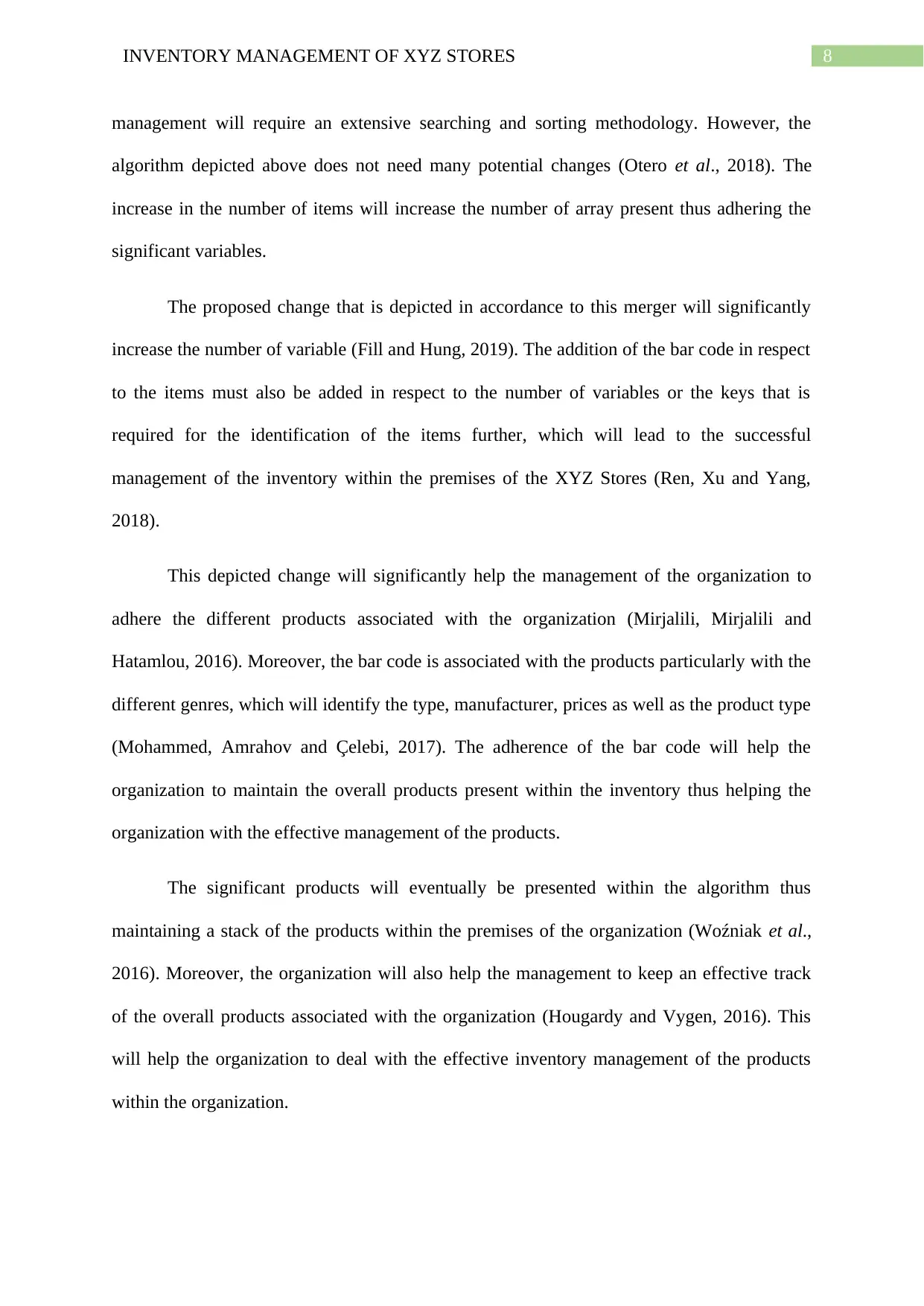
8INVENTORY MANAGEMENT OF XYZ STORES
management will require an extensive searching and sorting methodology. However, the
algorithm depicted above does not need many potential changes (Otero et al., 2018). The
increase in the number of items will increase the number of array present thus adhering the
significant variables.
The proposed change that is depicted in accordance to this merger will significantly
increase the number of variable (Fill and Hung, 2019). The addition of the bar code in respect
to the items must also be added in respect to the number of variables or the keys that is
required for the identification of the items further, which will lead to the successful
management of the inventory within the premises of the XYZ Stores (Ren, Xu and Yang,
2018).
This depicted change will significantly help the management of the organization to
adhere the different products associated with the organization (Mirjalili, Mirjalili and
Hatamlou, 2016). Moreover, the bar code is associated with the products particularly with the
different genres, which will identify the type, manufacturer, prices as well as the product type
(Mohammed, Amrahov and Çelebi, 2017). The adherence of the bar code will help the
organization to maintain the overall products present within the inventory thus helping the
organization with the effective management of the products.
The significant products will eventually be presented within the algorithm thus
maintaining a stack of the products within the premises of the organization (Woźniak et al.,
2016). Moreover, the organization will also help the management to keep an effective track
of the overall products associated with the organization (Hougardy and Vygen, 2016). This
will help the organization to deal with the effective inventory management of the products
within the organization.
management will require an extensive searching and sorting methodology. However, the
algorithm depicted above does not need many potential changes (Otero et al., 2018). The
increase in the number of items will increase the number of array present thus adhering the
significant variables.
The proposed change that is depicted in accordance to this merger will significantly
increase the number of variable (Fill and Hung, 2019). The addition of the bar code in respect
to the items must also be added in respect to the number of variables or the keys that is
required for the identification of the items further, which will lead to the successful
management of the inventory within the premises of the XYZ Stores (Ren, Xu and Yang,
2018).
This depicted change will significantly help the management of the organization to
adhere the different products associated with the organization (Mirjalili, Mirjalili and
Hatamlou, 2016). Moreover, the bar code is associated with the products particularly with the
different genres, which will identify the type, manufacturer, prices as well as the product type
(Mohammed, Amrahov and Çelebi, 2017). The adherence of the bar code will help the
organization to maintain the overall products present within the inventory thus helping the
organization with the effective management of the products.
The significant products will eventually be presented within the algorithm thus
maintaining a stack of the products within the premises of the organization (Woźniak et al.,
2016). Moreover, the organization will also help the management to keep an effective track
of the overall products associated with the organization (Hougardy and Vygen, 2016). This
will help the organization to deal with the effective inventory management of the products
within the organization.
⊘ This is a preview!⊘
Do you want full access?
Subscribe today to unlock all pages.

Trusted by 1+ million students worldwide
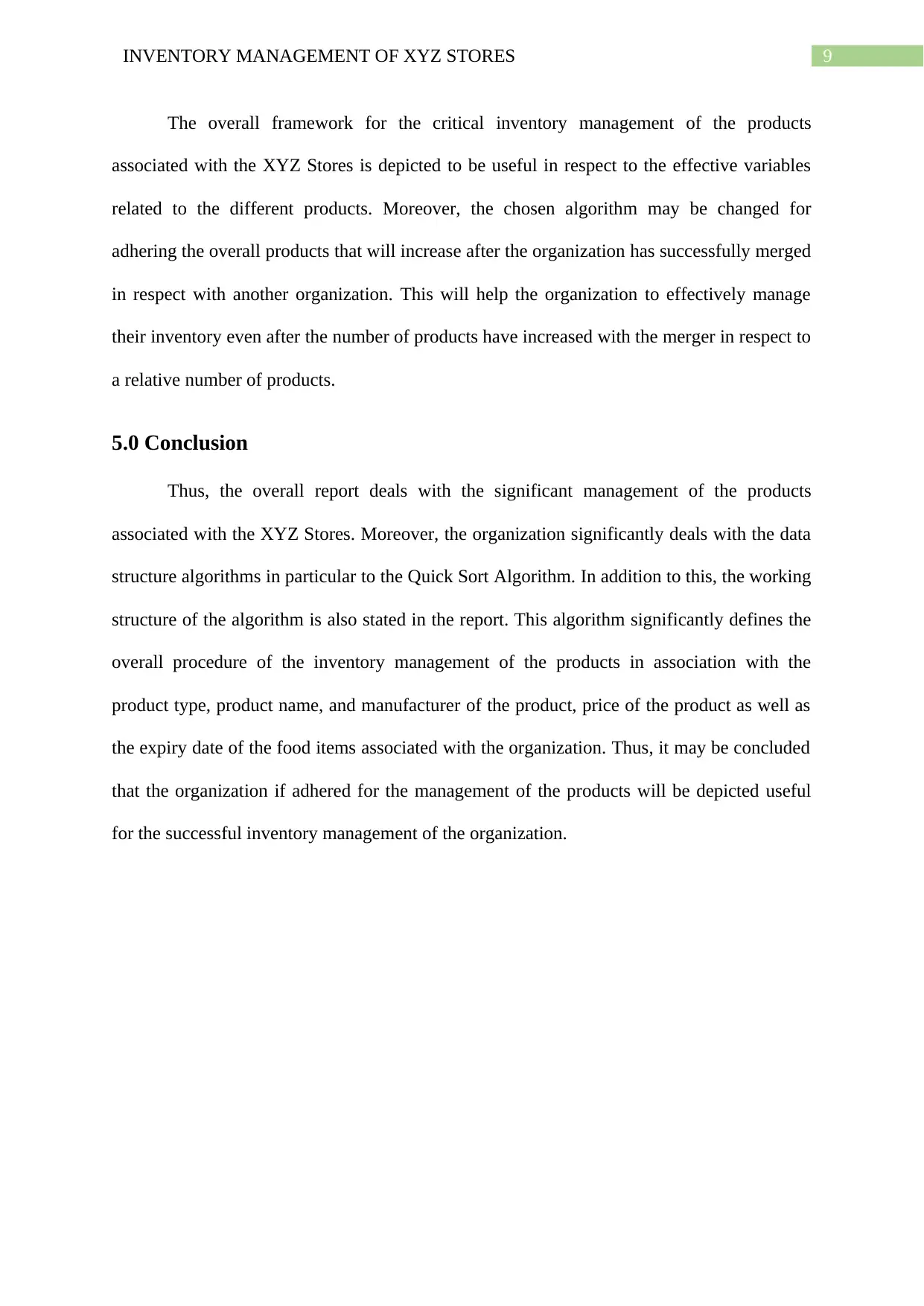
9INVENTORY MANAGEMENT OF XYZ STORES
The overall framework for the critical inventory management of the products
associated with the XYZ Stores is depicted to be useful in respect to the effective variables
related to the different products. Moreover, the chosen algorithm may be changed for
adhering the overall products that will increase after the organization has successfully merged
in respect with another organization. This will help the organization to effectively manage
their inventory even after the number of products have increased with the merger in respect to
a relative number of products.
5.0 Conclusion
Thus, the overall report deals with the significant management of the products
associated with the XYZ Stores. Moreover, the organization significantly deals with the data
structure algorithms in particular to the Quick Sort Algorithm. In addition to this, the working
structure of the algorithm is also stated in the report. This algorithm significantly defines the
overall procedure of the inventory management of the products in association with the
product type, product name, and manufacturer of the product, price of the product as well as
the expiry date of the food items associated with the organization. Thus, it may be concluded
that the organization if adhered for the management of the products will be depicted useful
for the successful inventory management of the organization.
The overall framework for the critical inventory management of the products
associated with the XYZ Stores is depicted to be useful in respect to the effective variables
related to the different products. Moreover, the chosen algorithm may be changed for
adhering the overall products that will increase after the organization has successfully merged
in respect with another organization. This will help the organization to effectively manage
their inventory even after the number of products have increased with the merger in respect to
a relative number of products.
5.0 Conclusion
Thus, the overall report deals with the significant management of the products
associated with the XYZ Stores. Moreover, the organization significantly deals with the data
structure algorithms in particular to the Quick Sort Algorithm. In addition to this, the working
structure of the algorithm is also stated in the report. This algorithm significantly defines the
overall procedure of the inventory management of the products in association with the
product type, product name, and manufacturer of the product, price of the product as well as
the expiry date of the food items associated with the organization. Thus, it may be concluded
that the organization if adhered for the management of the products will be depicted useful
for the successful inventory management of the organization.
Paraphrase This Document
Need a fresh take? Get an instant paraphrase of this document with our AI Paraphraser
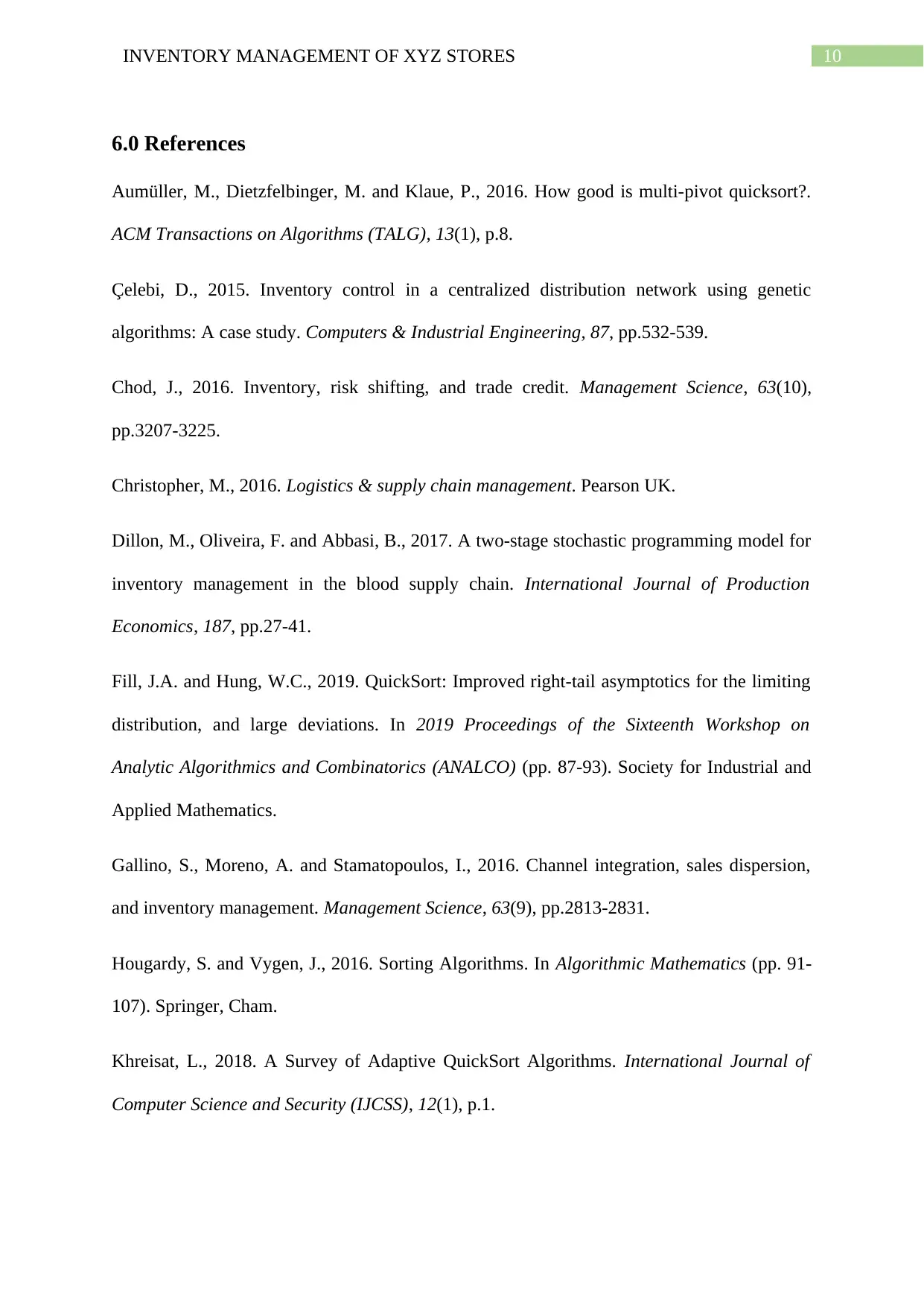
10INVENTORY MANAGEMENT OF XYZ STORES
6.0 References
Aumüller, M., Dietzfelbinger, M. and Klaue, P., 2016. How good is multi-pivot quicksort?.
ACM Transactions on Algorithms (TALG), 13(1), p.8.
Çelebi, D., 2015. Inventory control in a centralized distribution network using genetic
algorithms: A case study. Computers & Industrial Engineering, 87, pp.532-539.
Chod, J., 2016. Inventory, risk shifting, and trade credit. Management Science, 63(10),
pp.3207-3225.
Christopher, M., 2016. Logistics & supply chain management. Pearson UK.
Dillon, M., Oliveira, F. and Abbasi, B., 2017. A two-stage stochastic programming model for
inventory management in the blood supply chain. International Journal of Production
Economics, 187, pp.27-41.
Fill, J.A. and Hung, W.C., 2019. QuickSort: Improved right-tail asymptotics for the limiting
distribution, and large deviations. In 2019 Proceedings of the Sixteenth Workshop on
Analytic Algorithmics and Combinatorics (ANALCO) (pp. 87-93). Society for Industrial and
Applied Mathematics.
Gallino, S., Moreno, A. and Stamatopoulos, I., 2016. Channel integration, sales dispersion,
and inventory management. Management Science, 63(9), pp.2813-2831.
Hougardy, S. and Vygen, J., 2016. Sorting Algorithms. In Algorithmic Mathematics (pp. 91-
107). Springer, Cham.
Khreisat, L., 2018. A Survey of Adaptive QuickSort Algorithms. International Journal of
Computer Science and Security (IJCSS), 12(1), p.1.
6.0 References
Aumüller, M., Dietzfelbinger, M. and Klaue, P., 2016. How good is multi-pivot quicksort?.
ACM Transactions on Algorithms (TALG), 13(1), p.8.
Çelebi, D., 2015. Inventory control in a centralized distribution network using genetic
algorithms: A case study. Computers & Industrial Engineering, 87, pp.532-539.
Chod, J., 2016. Inventory, risk shifting, and trade credit. Management Science, 63(10),
pp.3207-3225.
Christopher, M., 2016. Logistics & supply chain management. Pearson UK.
Dillon, M., Oliveira, F. and Abbasi, B., 2017. A two-stage stochastic programming model for
inventory management in the blood supply chain. International Journal of Production
Economics, 187, pp.27-41.
Fill, J.A. and Hung, W.C., 2019. QuickSort: Improved right-tail asymptotics for the limiting
distribution, and large deviations. In 2019 Proceedings of the Sixteenth Workshop on
Analytic Algorithmics and Combinatorics (ANALCO) (pp. 87-93). Society for Industrial and
Applied Mathematics.
Gallino, S., Moreno, A. and Stamatopoulos, I., 2016. Channel integration, sales dispersion,
and inventory management. Management Science, 63(9), pp.2813-2831.
Hougardy, S. and Vygen, J., 2016. Sorting Algorithms. In Algorithmic Mathematics (pp. 91-
107). Springer, Cham.
Khreisat, L., 2018. A Survey of Adaptive QuickSort Algorithms. International Journal of
Computer Science and Security (IJCSS), 12(1), p.1.
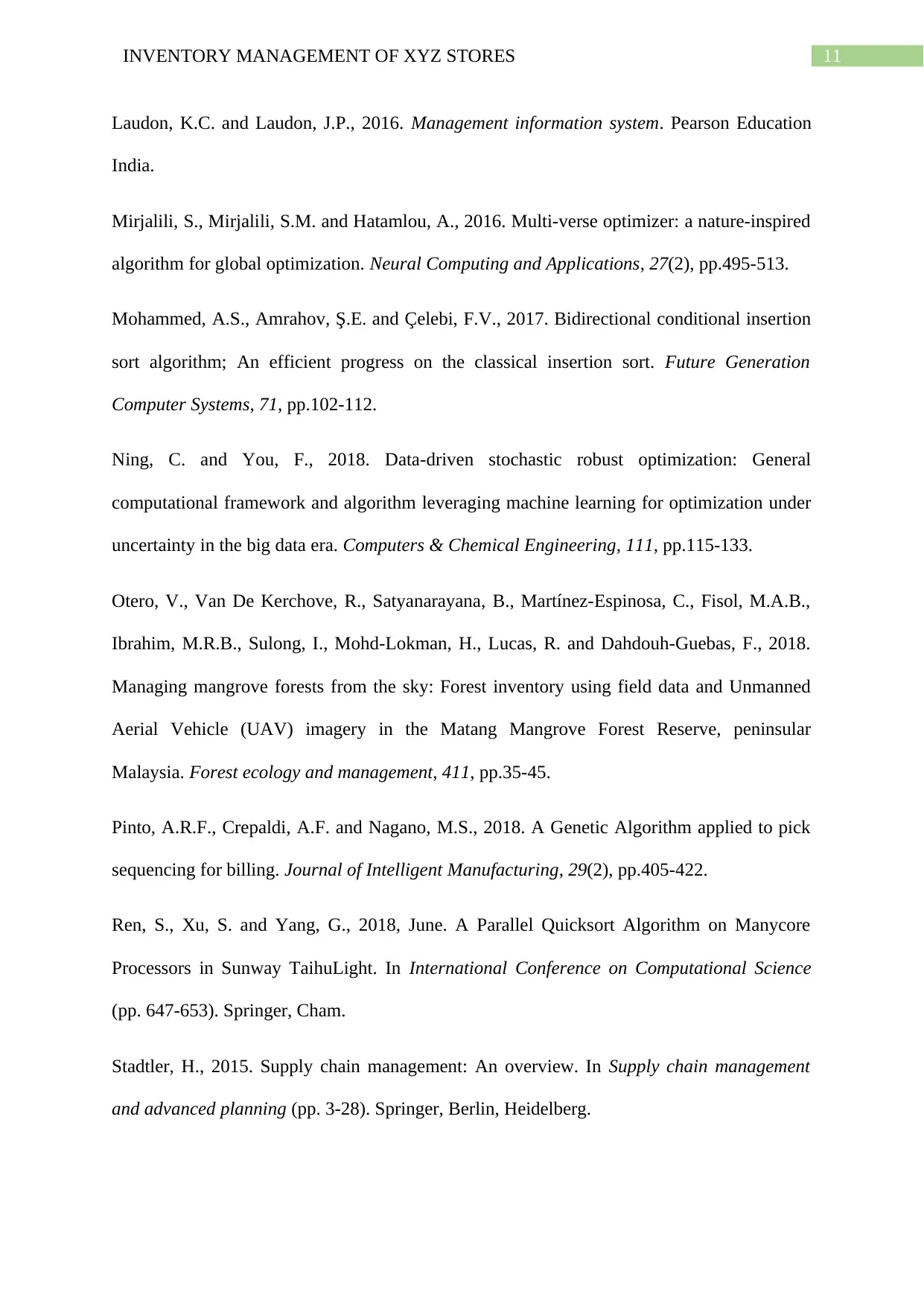
11INVENTORY MANAGEMENT OF XYZ STORES
Laudon, K.C. and Laudon, J.P., 2016. Management information system. Pearson Education
India.
Mirjalili, S., Mirjalili, S.M. and Hatamlou, A., 2016. Multi-verse optimizer: a nature-inspired
algorithm for global optimization. Neural Computing and Applications, 27(2), pp.495-513.
Mohammed, A.S., Amrahov, Ş.E. and Çelebi, F.V., 2017. Bidirectional conditional insertion
sort algorithm; An efficient progress on the classical insertion sort. Future Generation
Computer Systems, 71, pp.102-112.
Ning, C. and You, F., 2018. Data-driven stochastic robust optimization: General
computational framework and algorithm leveraging machine learning for optimization under
uncertainty in the big data era. Computers & Chemical Engineering, 111, pp.115-133.
Otero, V., Van De Kerchove, R., Satyanarayana, B., Martínez-Espinosa, C., Fisol, M.A.B.,
Ibrahim, M.R.B., Sulong, I., Mohd-Lokman, H., Lucas, R. and Dahdouh-Guebas, F., 2018.
Managing mangrove forests from the sky: Forest inventory using field data and Unmanned
Aerial Vehicle (UAV) imagery in the Matang Mangrove Forest Reserve, peninsular
Malaysia. Forest ecology and management, 411, pp.35-45.
Pinto, A.R.F., Crepaldi, A.F. and Nagano, M.S., 2018. A Genetic Algorithm applied to pick
sequencing for billing. Journal of Intelligent Manufacturing, 29(2), pp.405-422.
Ren, S., Xu, S. and Yang, G., 2018, June. A Parallel Quicksort Algorithm on Manycore
Processors in Sunway TaihuLight. In International Conference on Computational Science
(pp. 647-653). Springer, Cham.
Stadtler, H., 2015. Supply chain management: An overview. In Supply chain management
and advanced planning (pp. 3-28). Springer, Berlin, Heidelberg.
Laudon, K.C. and Laudon, J.P., 2016. Management information system. Pearson Education
India.
Mirjalili, S., Mirjalili, S.M. and Hatamlou, A., 2016. Multi-verse optimizer: a nature-inspired
algorithm for global optimization. Neural Computing and Applications, 27(2), pp.495-513.
Mohammed, A.S., Amrahov, Ş.E. and Çelebi, F.V., 2017. Bidirectional conditional insertion
sort algorithm; An efficient progress on the classical insertion sort. Future Generation
Computer Systems, 71, pp.102-112.
Ning, C. and You, F., 2018. Data-driven stochastic robust optimization: General
computational framework and algorithm leveraging machine learning for optimization under
uncertainty in the big data era. Computers & Chemical Engineering, 111, pp.115-133.
Otero, V., Van De Kerchove, R., Satyanarayana, B., Martínez-Espinosa, C., Fisol, M.A.B.,
Ibrahim, M.R.B., Sulong, I., Mohd-Lokman, H., Lucas, R. and Dahdouh-Guebas, F., 2018.
Managing mangrove forests from the sky: Forest inventory using field data and Unmanned
Aerial Vehicle (UAV) imagery in the Matang Mangrove Forest Reserve, peninsular
Malaysia. Forest ecology and management, 411, pp.35-45.
Pinto, A.R.F., Crepaldi, A.F. and Nagano, M.S., 2018. A Genetic Algorithm applied to pick
sequencing for billing. Journal of Intelligent Manufacturing, 29(2), pp.405-422.
Ren, S., Xu, S. and Yang, G., 2018, June. A Parallel Quicksort Algorithm on Manycore
Processors in Sunway TaihuLight. In International Conference on Computational Science
(pp. 647-653). Springer, Cham.
Stadtler, H., 2015. Supply chain management: An overview. In Supply chain management
and advanced planning (pp. 3-28). Springer, Berlin, Heidelberg.
⊘ This is a preview!⊘
Do you want full access?
Subscribe today to unlock all pages.

Trusted by 1+ million students worldwide
1 out of 13
Related Documents
Your All-in-One AI-Powered Toolkit for Academic Success.
+13062052269
info@desklib.com
Available 24*7 on WhatsApp / Email
![[object Object]](/_next/static/media/star-bottom.7253800d.svg)
Unlock your academic potential
Copyright © 2020–2025 A2Z Services. All Rights Reserved. Developed and managed by ZUCOL.





